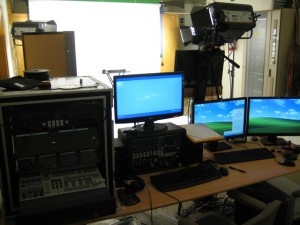The “POLI” mark: New technologies for university teaching

This article is part of Media and Learning month’s newsletter, dedicated series on lecture capture. It is provided by the Lifelong Learning project REC:all, which aims to explore new ways in which lecture capture can become more pedagogically valuable and engaging, and which is investigating a variety of learning design, technical and legal issues related to lecture capture. Marta Cabedo Fabrés from Universitat Politècnica de València (UPV), Spain – describes how.
The new educational paradigm due to the Bologna process, presents a teaching model in which the professor acts as facilitator of learning and the students assume an active and autonomous role. Based on these points the Universitat Politècnica de València (UPV) has developed and implemented a number of tools (POLIMEDIA, POLITUBE and POLICONECTA) and a Virtual Learning Environment (POLIFORMAT), in order to adapt to the European Higher Education Area and to improve teaching quality.
 POLIMEDIA is a system designed at the UPV for creating multimedia content (videos, instruction clips, knowledge clips, etc.), and POLITUBE is a free access portal enabled by the UPV to store educational videos that are used to support and complement classroom teaching.
POLIMEDIA is a system designed at the UPV for creating multimedia content (videos, instruction clips, knowledge clips, etc.), and POLITUBE is a free access portal enabled by the UPV to store educational videos that are used to support and complement classroom teaching.
The materials and resources available in POLITUBE and POLIMEDIA, after a rigorous review, are recognized as learning objects and become part of Riunet (UPV institutional repository). Riunet provides access from the Internet to the scientific, academic and corporate production of this university following the international movement of Open Access.
POLIFORMAT is a tele-education platform used in the UPV. It is based on Sakai and it offers a standardised interface for accessing to a Web 2.0 toolkit. It facilitates autonomous and collaborative learning to students.
Each subject has its own space in POLIFORMAT and it is accessible only to teachers and students enrolled in the subject. The tools available include news, calendar, repository of resources, tasks, contents, on-line exams, chat, internal mail, discussion forum, wiki and student’s personal space. Some of these tools can be activated during a specified period of time, according to the needs of the subjects.
POLICONECTA is a videoconferencing tool developed at the Lifelong Learning Center of the UPV for distance learning. It is based on
the use of commercial software Adobe Connect, and allows virtual meetings, video conferencing and remote lectures, which can be
recorded. It also includes the ability to share documents, applications or a whiteboard.
For the delivery of courses or seminars at a distance UPV makes more than 30 classrooms available which are properly equipped with multiple cameras, microphones, projector, monitors, and interactive whiteboard. Some classrooms also have “Paper Show” (a special notebook that records what you write or draw with a pen in a computer). The only equipment required by students is a broadband Internet connection, headphones and a microphone.
All tools and platform described in this article have already been used with a high degree of acceptance by more than 250 lecturers and approximately 36000 students at the UPV. In the last six years more than 3000 videos have been produced using these technologies and actual experiences show that the use of lecture captures results in a substantial improvement of teaching quality. Find out more.
UPV’s experience in lecture capture will be presented during the REC:all workshop taking place on 13 November.
 Follow
Follow